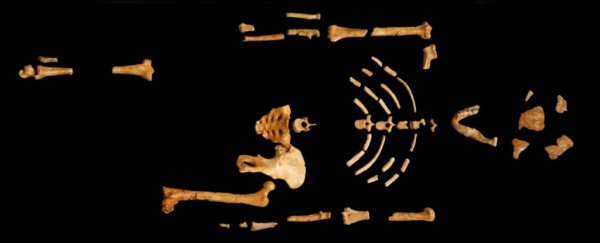Over four decades ago, scientists discovered the fossils of an early human ancestor that lived about 3.18 million years ago. Dubbing the skeletal remains 'Lucy', scientists have debated every aspect of the find ever since.
One of the biggest arguments between researchers is whether or not Lucy – who had both ape and human-like features – spent most of her time in the trees or walking on the ground. Now, thanks to advanced CT scans, we might finally know the answer.
According to a team of researchers from Johns Hopkins University and the University of Texas, Lucy – an early human ancestor known scientifically as Australopithecus afarensis – was likely very adept at tree climbing, so much so, that they can see markings of this ability in the way her bones were constructed.
Coming to that conclusion involved the team creating 35,000 CT scan slices that showed the innermost details of her bone structure. Analysis revealed that her upper limbs were extremely well-built, looking a lot like that of chimpanzees.
 Marsha Miller/University of Texas
Marsha Miller/University of Texas
On the other hand, scans of her feet also showed that she was well adapted for walking, putting in her an odd middle category between us modern humans – who spend hardly any time in the trees – and other primates that do.
"Our study is grounded in mechanical engineering theory about how objects can facilitate or resist bending, but our results are intuitive because they depend on the sorts of things that we experience about objects – including body parts – in everyday life," explains Christopher Ruff, from the Johns Hopkins University School of Medicine.
"If, for example, a tube or drinking straw has a thin wall, it bends easily, whereas a thick wall prevents bending. Bones are built similarly."
Using this hypothesis, the team was able to determine which parts of her body Lucy used on a regular basis and which parts were underused.
"It is a well-established fact that the skeleton responds to loads during life, adding bone to resist high forces and subtracting bone when forces are reduced," says Richard Ketcham from the University of Texas.
"Tennis players are a nice example: Studies have shown that the cortical bone in the shaft of the racquet arm is more heavily built up than that in the non-racquet arm."
This explains why chimpanzees have such strong arms while we modern humans have much more powerful legs. It's all about what we use the most often. To get more insight, the team also compared their new scans to scans of humans and modern chimpanzees to see the differences.
"Our results show that the upper limbs of chimpanzees are relatively more heavily built because they use their arms for climbing, with the reverse seen in humans, who spend more time walking and have more heavily built lower limbs," Ruff said.
"The results for Lucy are convincing and intuitive."
The team's hypothesis is further backed up by a previous study which found evidence that Lucy might have died after falling out of a tree. Although, one question now still remains: how much time did Lucy and early hominins like her spend in the trees?
In short, no one is quite sure right now. One of the most popular hypotheses is that she might have slept in the trees, providing her with cover from predators who stalked the night.
If that's true, she would have spent roughly one-third of her life in the trees if she slept an average of eight hours per day, though this number could be much higher if she also foraged for food in the canopy, too.
The current team also says that most of her body was extremely powerful for her body size – not just her hands and feet. This, they propose, is likely because she spent some time in the trees and some time walking, but everything about her life required her to be physical.
"It may seem unique from our perspective that early hominins like Lucy combined walking on the ground on two legs with a significant amount of tree climbing," Kappelman says.
"But Lucy didn't know she was 'unique' – she moved on the ground and climbed in trees, nesting and foraging there, until her life was likely cut short by a fall – probably out of a tree."
Hopefully, as scanning technology continues to get better and more detailed, we will be able to accurately understand how Lucy and other early human ancestors to paint a more completed picture of how we modern humans evolved to be what we are today.
The team's work was published in PLOS ONE.
